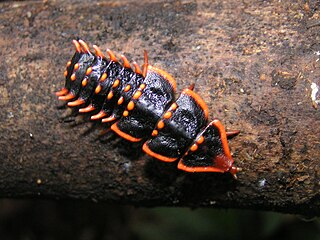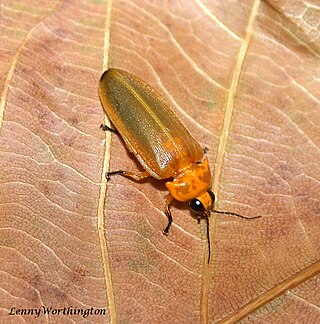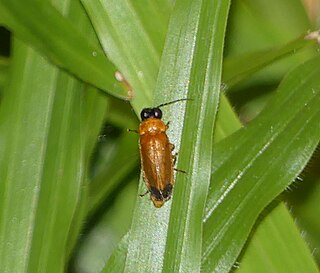
Luciola is a genus of "flashing" fireflies, especially well known from Japan. They are often called "Japanese fireflies", but their members range farther into Asia and reach southern Europe and Africa. This genus is traditionally held to extend to Australia, but these species do not seem to belong herein.

The Luciolinae are among the largest subfamilies of fireflies (Lampyridae). They seem to be all "flashing" fireflies. They are a diverse lineage, spreading throughout the warm parts of Eurasia into temperate Europe and East Asia and south to the Australian region.

Platerodrilus is a genus of beetles of the family Lycidae. They commonly appear in the literature under the name Duliticola, which is an obsolete junior synonym. The females retain a larval form as adults and are about 40–80 mm in length. The females and larvae have a flattened, dark body with large scales over the head, resembling trilobites, hence the informal names trilobite beetle, trilobite larva or Sumatran trilobite larva. In contrast, the males are much smaller, 8–9 mm, resembling other beetles. Species are found in tropical forests of India and South-east Asia.
Inflata is a genus of 'flashing' firefly found in Thailand, containing a single recognized species, Inflata indica.
Atyphella dalmatia is a species of firefly in the genus Atyphella. It was discovered in 2009.

Nipponoluciola cruciata, known as "genji-botaru" (ゲンジボタル) in Japanese, is a species of firefly found in Japan. Its habitat is small ditches and streams, and its larvae are aquatic. It was formerly known as Luciola cruciata but was revised taxonomically in 2022.
Aquatica ficta is a species of firefly found in Taiwan and parts of China. It was formerly placed in the genus Luciola. Its habitat is still water, and the larvae are aquatic.
Aquatica is a genus of fireflies in the subfamily Luciolinae. The species are found in China, Taiwan, Japan, Russia and Korea. Fu, Ballantyne and Lambkin erected the genus in 2010, using phylogenetic, morphological and behavioural evidence. Its type species is Aquatica wuhana. It contains five species:
Aquatica hydrophila is a species of firefly found in Taiwan. Described in 2003, it was formerly placed in the genus Luciola. The larvae are aquatic and live in ditches and small streams.

Aquatica lateralis, known as "heike-botaru" (ヘイケボタル) in Japanese, is a species of firefly found in Russia, Japan and Korea. It was formerly placed in the genus Luciola. The larvae are aquatic and live in rice paddies.
Luciola substriata is a species of firefly found in India, Myanmar, China and Taiwan. The larvae are aquatic and can swim, living in marshes, paddies, lakes and ponds.
Abscondita chinensis, is a species of firefly beetle found in India, China and Sri Lanka.
Abscondita promelaena, is a species of firefly beetle found in India and Sri Lanka.

Asymmetricata humeralis is a species of firefly found in India and Sri Lanka.
Luciola candezei, is a species of firefly beetle found in Sri Lanka.
Luciola intricata, is a species of firefly beetle found in Sri Lanka.
Luciola antennalis, is a species of firefly beetle found in Sri Lanka.

Pteroptyx is a genus of fireflies in the subfamily Luciolinae found in Southeast Asia. It has long been noted for the ability to perform synchronous flashing, though not all species synchronize. These synchronizing species have been found on so-called 'firefly trees' and created a growing firefly-watching tour industry in some regions. Species of the genus have been identified in Malaysia, Thailand, the Philippines, and Hong Kong.

Abscondita is a genus of fireflies in tropical Asia. Species in the genus were earlier placed in the genus Luciola but molecular phylogeny studies support their separation.

Asymmetricata is a genus of fireflies found in tropical Asia. Species in the genus were formerly included in the genus Luciola. The genus was created in 2009 by Lesley Ballantyne who noted the asymmetric 8th abdominal tergite, emarginated on its left, as a shared feature. Adults of both males and females are winged. The larvae have been reliably described only in A. circumdata. They are terrestrial carnivores, feeding on snails and earthworms in moist soil below tree cover. The last abdominal segment bears an anchoring structure or pygopod with 58 or more pygopodia arising from it.






